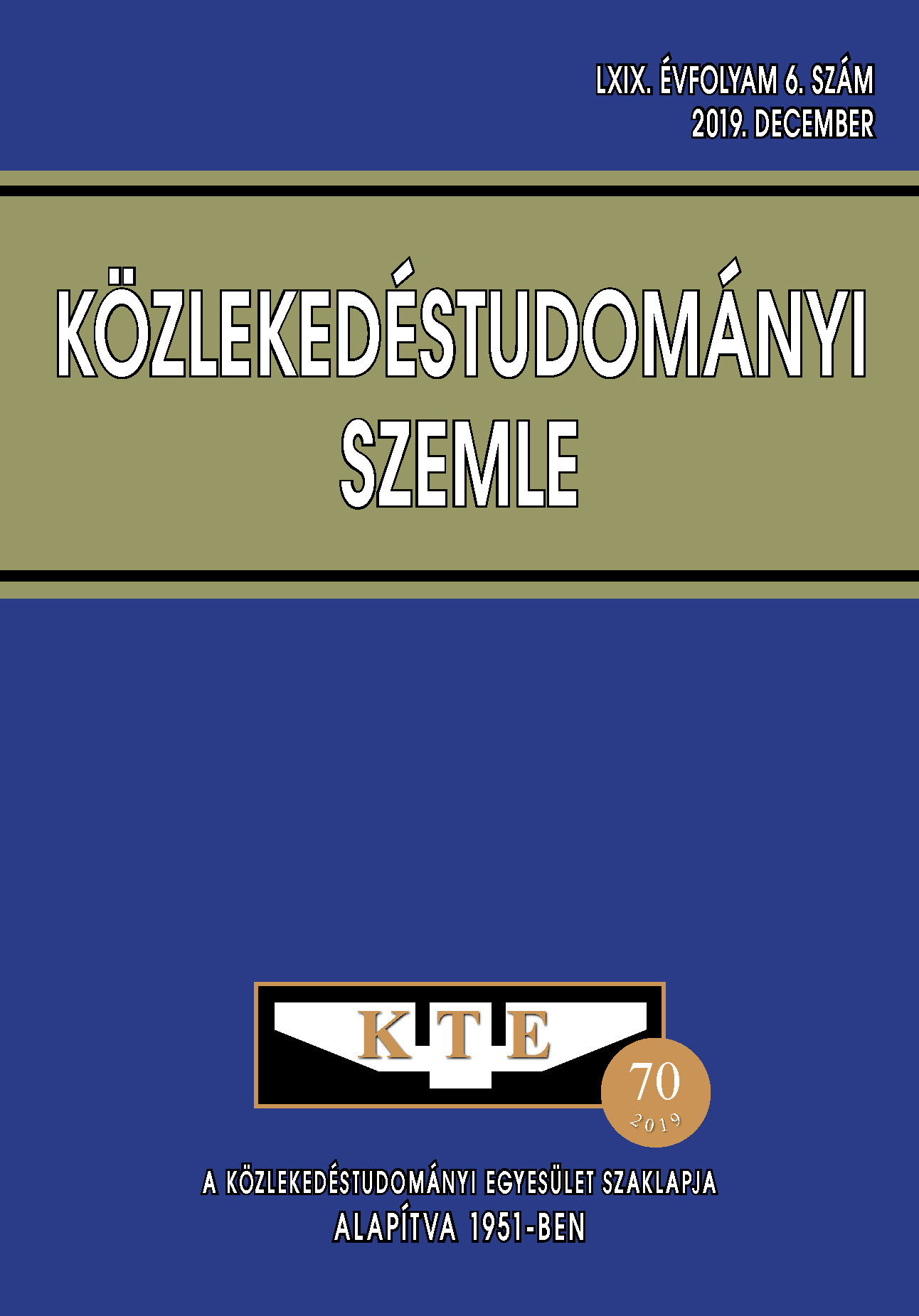Sztochasztikus lökéshullámmodell levezetése és alkalmazási lehetőségei
Absztrakt
Forgalmas városi útvonalakon a jelzőlámpaciklusok alapvetően meghatározzák a forgalom lebonyolódását. A jelzőlámpás útkereszteződésekben a kialakuló sorhosszak pontos ismerete elengedhetetlen az intelligens beavatkozó rendszerek működtetése esetén. Fő eredmény, hogy a sztochasztikus lökéshullámmodell jól alkalmazható a városi forgalom modellezésére.
Hivatkozások
P. B. Hunt, D. I. Robertson, R.D. Bretherton, and R. I. Winton,“SCOOT - A traffic responsive method of coordinating signals,” TRL Lab., Wokingham, U.K., Tech. Rep. 1014, 1981
V. Mauro and C. D. Taranto, “UTOPIA,” in Control, Computers, Communications in Transportation Research, J. P. Perrin, Ed. Oxford,U.K.: Pergamon, 1990, pp. 245–252. DOI: http://doi.org/ddn9
A. A. Zaidi, B. Kulcsár, H. Wymeersch, Back-pressure traffic signal control with fixed and adaptive urban vehicular networks, IEEE Transactions on Intelligent Transportation Systems 17 (8) (2016) 2134-2143. DOI: http://doi.org/f3scmz
H. Yang, H. Rakha, M. V. Ala, Eco-cooperative adaptive cruise control at signalized intersections considering queue effects, IEEE Transactions on Intelligent Transportation Systems 18 (6) (2017) 1575-1585. DOI: http://doi.org/ddpb
A. Sharma, D. Bullock, J. Bonneson, Input-output and hybrid techniques for real-time prediction of delay and maximum queue length at signalized intersections, Transportation Research Record: Journal of the transportation Research Board 8 (2035) (2007) 69{80. DOI: http://doi.org/fw429q
M. Fathy, M. Siyal, A window-based image processing technique for quantitative and qualitative analysis of road traffic parameters, IEEE Transactions on Vehicular Technology 47 (4) (1998) 1342{1349. DOI: http://doi.org/czdn5t
G. Comert, M. Cetin, Queue length estimation from probe vehicle location and the impacts of sample size, European Journal of Operational Research 197 (1) (2009) 196-202. DOI: http://doi.org/dj5z45
H. X. Liu, X. Wu, W. Ma, H. Hu, Real-time queue length estimation for congested signalized intersections, Transportation Research part C: Emerging Technologies 17 (4) (2009) 412-427. DOI: http://doi.org/dprtn9
D. Heidemann, Queue length and delay distributions at traffic signals, Transportation Research Part B: Methodological 28 (5) (1994) 377-389. DOI: http://doi.org/d6rt6h
G. K. Mung, A. C. Poon, W. H. Lam, Distributions of queue lengths at fixed time traffic signals, Transportation Research Part B: Methodological 30 (6) (1996) 421-439. DOI: http://doi.org/bfdhmz
F. Zheng, S. E. Jabari, H. X. Liu, D. Lin, Traffic state estimation using stochastic Lagrangian dynamics, Transportation Research Part B: Methodological 115 (2018) 143-165. DOI: http://doi.org/gd7zrc
X. Wu, H. X. Liu, A shockwave profile model for traffic flow on congested urban arterials, Transportation Research Part B: Methodological 45 (10) (2011) 1768-1786. DOI: http://doi.org/dpjqxq
Luspay T., Tettamanti T., Varga I.: Forgalomirányítás, Közúti járműforgalom modellezése és irányítása, ISBN 978-963-279-665-9, Typotex Kiadó, Budapest, 2011
K Aboudolas, M. Papageorgiou, E. Kosmatopoulos, Store-and-Forward based methods for the signal control problem in large-scale congested urban road networks, Transportation Research Part C: Emerging Technologies 17 (2) (2009) 163-174. DOI: http://doi.org/dv7df6
L. Arnold, Random dynamical systems, Springer Science and Business Media, 2013.
D. Heidemann, Queue length and delay distributions at traffic signals, Transportation Research Part B: Methodological 28 (5) (1994) 377-389. DOI: http://doi.org/d6rt6h
S. Karlin, A first course in stochastic processes, 2nd Edition, Academic Press, 1957, DOI: http://doi.org/ddpd
Leyn, U. and Vortisch, P, Calibrating VISSIM for the German Highway Capacity Manual. Karlsruhe Institute of Technology: Institute for Transport Studies, (2014) 1-11. DOI: http://doi.org/ddpf
Az elektronikusan megjelenő cikkek nyílt hozzáféréssel rendelkeznek (OJS), online ingyenesen elérhetők és letölthetők. A cikkek szerzőit nem terheli megjelentetési vagy kiadási költség (APC). Felhasználóknak joguk van a cikkek olvasására, letöltésére, másolására, kinyomtatására, valamint azokban való keresésre, vagy a teljes szöveg linkkel történő megosztására.
A szerzőknek nyilatkozniuk kell arról, hogy beadványukat korábban nem tették közzé más folyóiratban, a pénzügyi támogatás feltüntetésre került és a hivatkozások listája teljes és pontos, beleértve az URL-ek és a DOI-k specifikációját is (ha rendelkezésre állnak). A cikktervezet beadásakor minden szerző jóváhagyja a benyújtott változatot. A szerzők garantálják, hogy a cikk az ő eredeti művük. A szerzők kötelesek részt venni a szakértői értékelés folyamatában, követni a bírálók tanácsait, betartani az előírt határidőket, és amennyiben előfordulnak, kötelesek visszavonni a benyújtást vagy kijavítani a hibákat.
Minden beadott cikket szakértői értékelés alá kerül, ahol a szerkesztők független értékelést kérnek legalább egy szakértőtől, ügyelve arra, hogy a bíráló(k)nak ne legyen összeférhetetlensége a szerzőkkel. A végső döntést a főszerkesztő hozza meg, aki figyelembe veszi az értékeléseket és a szerkesztők javaslatait. A szerkesztők és a lektorok bizalmasan kezelik a beadványt.
A kiadó és a szerkesztők elkötelezettek a magas etikai normák betartása mellett, és megakadályozzák azokat a publikációkat, amelyekben kutatási visszaélés történt. Az ilyen etikai kérdésekben a COPE irányelveit követik.
A szerzők fenntartják a szerzői jogokat, és megadják a folyóiratnak az első közzétételi jogot a Creative Commons Licenc alapján (https://creativecommons.org/licenses/by-nc-nd/4.0), amely lehetővé teszi mások számára, hogy megosszák a művet, elismerve a mű szerzőségét és a folyóiratban való első közzétételt.
A folyóirat archiválja az összes megjelent cikket, és a folyóirat tulajdonosa, a Közlekedéstudományi Egyesület továbbra is üzemelteti az adatbázist abban az esetben is, ha a folyóirat kiadása megszűnik.















